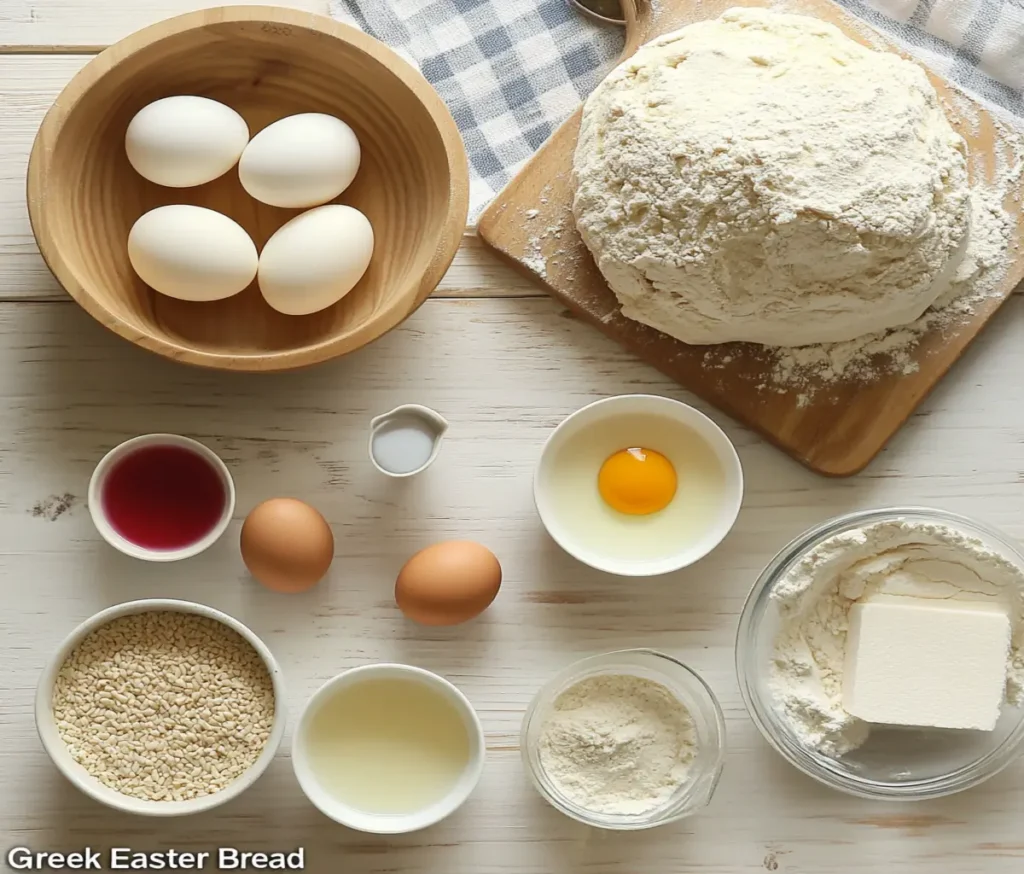There’s something magical about Easter in a Greek household—the aroma of baking bread, the laughter of cousins running around, and the bright red eggs nestled in sweet, braided loaves. Greek Easter Bread, or Tsoureki, is more than just a recipe; it’s a treasured tradition that has been passed down through generations.
I still remember my yiayia (grandmother) kneading the soft, fragrant dough, humming a hymn as she worked. She taught me that Tsoureki isn’t just about baking—it’s about celebrating rebirth, family, and heritage. The rich, buttery flavor and distinctive braided shape symbolize continuity and unity, while the red eggs honor the resurrection.
Let’s dive into this timeless recipe and bring the spirit of Greek Easter into your kitchen.
What Is Greek Easter Bread?
Greek Easter Bread, or Tsoureki, is a sweet, enriched bread traditionally prepared during Orthodox Easter. It’s often flavored with unique spices like mahlab (from wild cherry pits) and mastic, but in this simplified version, we use pantry staples to create a rich, slightly sweet loaf with a tender crumb and golden crust.
The braided design symbolizes the Holy Trinity, while the red-dyed eggs (optional) represent the blood of Christ. Though steeped in symbolism, Tsoureki is beloved by all for its incredible flavor and beautiful presentation.
Ingredients You’ll Need for Greek Easter Bread Recipe

For the Dough:
- ½ cup warm water (about 110°F/43°C)
- 2¼ teaspoons active dry yeast (1 packet)
- ½ cup granulated sugar
- ¼ cup olive oil
- ⅔ cup milk (warm)
- 1 teaspoon salt
- 4½ cups all-purpose flour (plus extra for kneading)
- 2 large eggs
For the Egg Wash:
- 1 egg yolk, beaten with 1 tablespoon water
Decoration (Optional):
- 2 hard-boiled eggs, dyed red
- 1 tablespoon sesame seeds
- 1 tablespoon coarse sugar
How to Make Greek Easter Bread
Step 1: Activate the Yeast
In a small bowl, combine the warm water and active dry yeast. Add a pinch of sugar and let it sit for 10 minutes until it becomes frothy. This step ensures your yeast is alive and ready to leaven your dough.
💡 Tip: If the mixture doesn’t bubble, your yeast may be expired—try again with fresh yeast.
Step 2: Prepare the Wet Ingredients for Greek Easter Bread Recipe
In a large mixing bowl, whisk together the sugar, olive oil, warm milk, and salt. Once the yeast is activated, stir it into the mixture until well combined.
Step 3: Add the Flour and Eggs
Gradually add the flour, one cup at a time, mixing gently. Then beat in the eggs one at a time. The dough will start to come together. When it becomes too stiff to stir, transfer it to a floured surface.
Step 4: Knead the Dough
Knead the dough for about 10 minutes, until it becomes smooth and elastic. This is a beautiful time to get hands-on and feel the texture transform under your fingers.
Step 5: First Rise
Place the dough in a greased bowl, cover it with a clean kitchen towel, and let it rise in a warm place for 1 to 1.5 hours, or until it doubles in size.
Step 6: Shape the Loaf
Punch down the dough and divide it into three equal parts. Roll each into a rope, then braid them together to form a loaf. If you’re using red eggs, gently press them between the strands of dough.
🎨 Optional Touch: Sprinkle sesame seeds and coarse sugar over the top for a golden, slightly crunchy crust.
Step 7: Second Rise
Place the braided dough on a greased baking sheet. Cover it and let it rise again for 30 minutes.
Step 8: Bake to Golden Perfection
Preheat your oven to 350°F (175°C). Brush the loaf with egg wash, then bake for 30-35 minutes, or until deeply golden brown. Let it cool on a wire rack before slicing.

What to Serve with Greek Easter Bread
Tsoureki is delicious on its own, but it pairs beautifully with:
- Greek yogurt and honey
- Feta cheese and olives
- A cup of strong Greek coffee or tea
It also makes incredible French toast the next day—just dip slices in an egg-milk mixture and pan-fry until golden.
How to Store Greek Easter Bread
To keep it fresh:
- Store in an airtight container at room temperature for up to 3 days.
- Freeze slices in a zip-top bag for up to 2 months. Reheat gently in a toaster or oven.
Why You’ll Love Greek Easter Bread Recipe
- ✅ No special ingredients like mahleb or mastic needed
- ✅ Perfect balance of sweet and savory
- ✅ Gorgeous presentation for holiday tables
- ✅ Kid-friendly and great for gifting
- ✅ Traditional yet approachable for home bakers
Reader Tips & Variations
- Add Orange Zest: A fresh citrus note that lifts the sweetness.
- Swap Olive Oil for Butter: For an even richer taste.
- Try It with Cardamom: For a more aromatic twist.
Have you made this recipe? I’d love to hear your twist! Share your photos and comments below or tag me on Instagram with #GreekEasterWithSarah.
Nutrition Facts (Per Slice)
- Calories: 250
- Carbohydrates: 35g
- Protein: 6g
- Fat: 9g
- Sugar: 7g
The Historical Roots of Greek Easter Bread
Tsoureki’s origins trace back to the Byzantine era, where it was more than just a festive treat—it was a symbol of life and renewal. The tradition of baking this bread during Easter has been a cornerstone in Greek households for centuries, representing the resurrection of Christ and the rebirth of nature in spring .Hina Munawar
The name “Tsoureki” is believed to have been derived from the Turkish word “çörek,” indicating a sweet, leavened bread. Over time, the recipe evolved, incorporating local ingredients and flavors, yet its essence as a celebratory bread remained unchanged .Histoire de la cuisine grecque
Symbolism Woven into Every Loaf
Every element of Tsoureki carries profound symbolism:Urbaki Cooking+1The Greek Delicatessen+1
- Braided Design: Typically, Tsoureki is braided into three strands, symbolizing the Holy Trinity—the Father, the Son, and the Holy Spirit .TheGreekHerbivore
- Red-Dyed Eggs: Often nestled within the braids are red-dyed eggs, representing the blood of Christ and the promise of eternal life .Hungry Happens+1GreekReporter.com+1
- Rising Dough: The act of the dough rising is seen as a metaphor for Christ’s resurrection, bringing the bread to life as it bakes .Slurrp
Regional Variations and Unique Twists
While the traditional Tsoureki recipe is cherished, various regions in Greece have introduced their own unique touches:
- Flavor Enhancements: Some recipes incorporate aromatic spices like mahleb (derived from cherry pits) and mastic (a resin from the mastic tree), adding a distinctive flavor profile to the bread .
- Shape and Design: Beyond the classic braid, certain areas craft Tsoureki into circular shapes or even intricate designs, each with its own local significance .Histoire de la cuisine grecque
- Additional Ingredients: In some households, ingredients like orange zest, almonds, or even dried fruits are added, offering a delightful variation to the traditional taste .
Tsoureki in Contemporary Celebrations
Today, Tsoureki remains a staple in Greek Easter celebrations, but its appeal has transcended religious boundaries. It’s now enjoyed year-round, often gifted during holidays or shared among friends and family as a gesture of goodwill.
Baking Tsoureki has become a cherished family tradition, with recipes passed down through generations. The process of preparing the dough, braiding it, and watching it rise and bake is a communal activity, bringing loved ones together in the kitchen.
Embracing the Tradition
Whether you’re continuing a family tradition or exploring new culinary horizons, baking Tsoureki offers a connection to a rich cultural heritage. It’s more than just bread; it’s a symbol of faith, unity, and the joyous spirit of Easter.
So, as you prepare your own Tsoureki, remember the generations before who have kneaded, braided, and baked with love, infusing each loaf with meaning and tradition.
A Final Word from My Kitchen
Greek Easter Bread isn’t just a seasonal bake—it’s a heartfelt tradition. Whether you’re baking it for a holiday table or to bring a little springtime joy to your kitchen, I hope this recipe becomes part of your family’s celebrations too.
Conclusion
Greek Easter Bread, or Tsoureki, is so much more than a seasonal treat—it’s a celebration of faith, family, and tradition. With its soft, fragrant crumb and golden braid, this bread brings warmth and meaning to every Easter table. Whether you’re honoring your heritage or simply exploring the flavors of Greek culture, baking Tsoureki is a beautiful way to connect with something deeper.
From the joy of watching the dough rise to the moment you break into a warm slice fresh out of the oven, every step of this recipe is a journey in itself. It invites you to slow down, reflect, and share something truly special with your loved ones.
So light a candle, gather your ingredients, and let the sweet scent of Tsoureki fill your kitchen. May it bring comfort, connection, and a taste of timeless tradition.
From my grandmother’s kitchen to yours—Kalo Pascha! (Happy Easter!)
